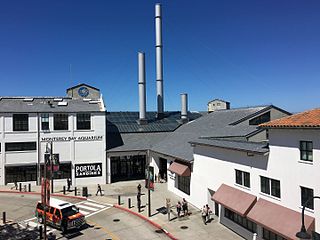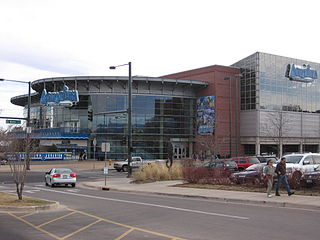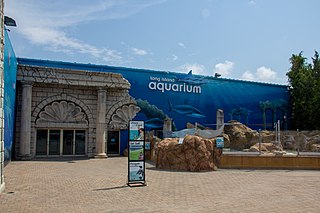
Marine mammals are mammals that rely on marine (saltwater) ecosystems for their existence. They include animals such as cetaceans, pinnipeds, sirenians, sea otters and polar bears. They are an informal group, unified only by their reliance on marine environments for feeding and survival.

The Steller sea lion is a large, near-threatened species of sea lion, predominantly found in the coastal marine habitats of the northeast Pacific Ocean and the Pacific Northwest regions of North America, from north-central California to Oregon, Washington and British Columbia to Alaska. Its range continues across the Northern Pacific and the Aleutian Islands, all the way to Kamchatka, Magadan Oblast, and the Sea of Okhotsk, south to Honshu's northern coastline. It is the sole member of the genus Eumetopias, and the largest of the so-called eared seals (Otariidae). Among pinnipeds, only the walrus and the two species of elephant seal are bigger. The species is named for the naturalist and explorer Georg Wilhelm Steller, who first described them in 1741. Steller sea lions have attracted considerable attention in recent decades, both from scientists and the general public, due to significant declines in their numbers over an extensive portion of their northern range, notably in Alaska.

Monterey Bay Aquarium is a nonprofit public aquarium in Monterey, California. Known for its regional focus on the marine habitats of Monterey Bay, it was the first to exhibit a living kelp forest when it opened in October 1984. Its biologists have pioneered the animal husbandry of jellyfish and it was the first to successfully care for and display a great white shark. The organization's research and conservation efforts also focus on sea otters, various birds, and tunas. Seafood Watch, a sustainable seafood advisory list published by the aquarium beginning in 1999, has influenced the discussion surrounding sustainable seafood. The aquarium was home to Otter 841 prior to her release into the wild as well as Rosa, the oldest living sea otter at the time of her death.

The National Aquarium – also known as National Aquarium in Baltimore and formerly known as Baltimore Aquarium – is a non-profit public aquarium located at 501 East Pratt Street on Pier 3 in the Inner Harbor area of downtown Baltimore, Maryland in the United States. Constructed during a period of urban renewal in Baltimore, the aquarium opened on August 8, 1981. The aquarium has an annual attendance of 1.5 million visitors and is the largest tourism attraction in the State of Maryland. The aquarium holds more than 2,200,000 US gallons (8,300,000 L) of water, and has more than 17,000 specimens representing over 750 species. The National Aquarium's mission is to inspire conservation of the world's aquatic treasures. The aquarium's stated vision is to confront pressing issues facing global aquatic habitats through pioneering science, conservation, and educational programming.

Shedd Aquarium is an indoor public aquarium in Chicago. Opened on May 30, 1930, the 5 million US gal aquarium holds about 32,000 animals and is the third largest aquarium in the Western Hemisphere, after the Georgia Aquarium and Monterey Bay Aquarium.

The sea otter is a marine mammal native to the coasts of the northern and eastern North Pacific Ocean. Adult sea otters typically weigh between 14 and 45 kg, making them the heaviest members of the weasel family, but among the smallest marine mammals. Unlike most marine mammals, the sea otter's primary form of insulation is an exceptionally thick coat of fur, the densest in the animal kingdom. Although it can walk on land, the sea otter is capable of living exclusively in the ocean.

The Seattle Aquarium is a public aquarium in Seattle, Washington, United States, located on Pier 59 on the Elliott Bay waterfront. The aquarium opened in 1977 and is accredited by the Association of Zoos and Aquariums (AZA).

The Vancouver Aquarium is a public aquarium located in Stanley Park in Vancouver, British Columbia, Canada. In addition to being a major tourist attraction for Vancouver, the aquarium is a centre for marine research, ocean literacy education, climate activism, conservation and marine animal rehabilitation.

The New England Aquarium is a nonprofit organization located in Boston, Massachusetts. The species exhibited include harbor and northern fur seals, California sea lions, African and southern rockhopper penguins, giant Pacific octopuses, weedy seadragons, and thousands of saltwater and freshwater fishes. In addition to the main aquarium building, attractions at Central Wharf include the Simons Theatre and the New England Aquarium Whale Watch. More than 1.3 million guests visited the aquarium each year prior to the outbreak of the COVID-19 pandemic.

Downtown Aquarium is a for profit aquarium and restaurant located in Denver, Colorado, at the intersection of I-25 and 23rd Ave. The 107,000 square feet (9,900 m2) main building sits on a 17-acre (6.9 ha) site adjacent to the South Platte River. Its freshwater and marine aquaria total approximately 1,000,000 US gallons (3,785,000 L), and exhibit a variety of fish and other animals.

The Maritime Aquarium at Norwalk is an aquarium located in the South Norwalk section of Norwalk, Connecticut.

The Marine Mammal Protection Act (MMPA) was the first act of the United States Congress to call specifically for an ecosystem approach to wildlife management.

The Great Lakes Aquarium opened in 2000 and is located on the Duluth waterfront. A 501(c)(3) private nonprofit, Great Lakes Aquarium features animals and habitats found within the Great Lakes basin and other worldwide ecosystems such as the Amazon River or Pacific reefs. The aquarium houses 205 different species of fish, birds, reptiles, amphibians, and mammals. It is one of few aquariums in the United States that focuses predominantly on freshwater exhibits.

The Marine Mammal Center (TMMC) is a private, non-profit U.S. organization that was established in 1975 for the purpose of rescuing, rehabilitating and releasing marine mammals who are injured, ill or abandoned. It was founded in Sausalito, California, by Lloyd Smalley, Pat Arrigoni and Paul Maxwell. Since 1975, TMMC has rescued over 24,000 marine mammals. It also serves as a center for environmental research and education regarding marine mammals, namely cetaceans, pinnipeds, otters and sirenians. Marine mammal abandonment refers to maternal separation; pups that have been separated from their mother before weaning. At the center, they receive specialized veterinary care: they are diagnosed, treated, rehabilitated and ideally, released back into the wild. Animals in need of assistance are usually identified by a member of the public who has contacted the center. These animals represent the following major species: California sea lions, northern elephant seals, Pacific harbor seals, northern fur seals, Guadalupe fur seals, Hawaiian monk seals, and southern sea otters. On a few occasions, TMMC has taken in Steller sea lions and bottlenose/Pacific white-sided dolphins. The only non-mammals that TMMC takes in are sea turtles.
Mystic Aquarium is a marine aquarium in Mystic, Connecticut. It is one of only two U.S. facilities holding Steller sea lions, and it has the only beluga whales in New England. Special exhibits include the largest outdoor beluga whale habitat in the United States, a ray and shark touch pool, an African penguin exhibit, a jelly gallery, and the new Dino Seas: An Immersive Journey exhibit. The aquarium is a member of the Alliance of Marine Mammal Parks and Aquariums (AMMPA) and is an accredited member of the Association of Zoos and Aquariums (AZA). It is a subsidiary of the Sea Research Foundation, Inc.

A public aquarium (pl. aquaria) or public water zoo is the aquatic counterpart of a zoo, which houses living aquatic animal and plant specimens for public viewing. Most public aquariums feature tanks larger than those kept by home aquarists, as well as smaller tanks.

The Virginia Aquarium & Marine Science Center, formerly known as the Virginia Marine Science Museum, is an aquarium and marine science museum located in Virginia Beach, Virginia, just south of Rudee Inlet. The exhibits at the museum are contained in over 800,000 US gallons (3,028,000 L) of fresh and saltwater displays.

Sea otter conservation began in the early 20th century, when the sea otter was nearly extinct due to large-scale commercial hunting. The sea otter was once abundant in a wide arc across the North Pacific ocean, from northern Japan to Alaska to Mexico. By 1911, hunting for the animal's luxurious fur had reduced the sea otter population to fewer than 2000 individuals in the most remote and inaccessible parts of its range. The IUCN lists the sea otter as an endangered species. Threats to sea otters include oil spills, and a major spill can rapidly kill thousands of the animals.

Long Island Aquarium is an aquarium that opened in 2000 on Long Island in Riverhead, New York, United States.

Randall William Davis is an American educator and researcher who studies the physiology and behavioral ecology of marine mammals and other aquatic vertebrates. His physiological research focuses on adaptations of marine mammals for deep, prolonged diving. Davis has continually emphasized the importance of studying aquatic animals in their natural environment and has spent many years developing animal-borne instruments that record video and monitor three-dimensional movements, swimming performance and environmental variables to better understand their behavior and ecology. His academic endeavors and 94 research expeditions have taken him to 64 countries and territories on seven continents and all of the world's oceans.





















